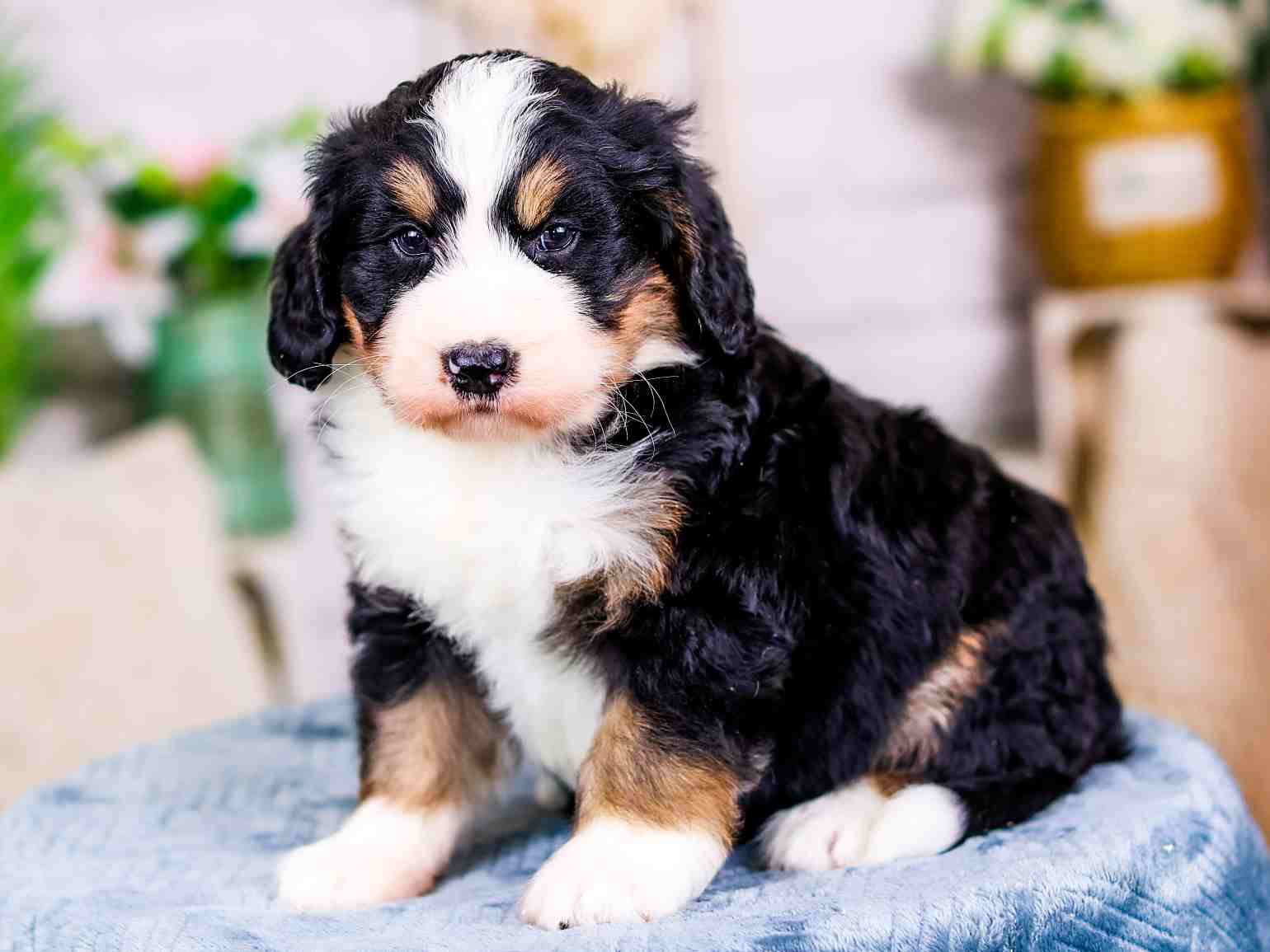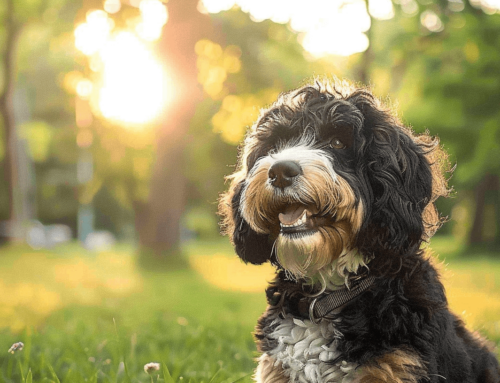Is your family considering a Sheepadoodle or Bernedoodle for your next pet? Both dog breeds are excellent family dogs, but each has unique characteristics that might sway your selection one way or the other. Here are the seven key differences between Bernedoodles and Sheepadoodles to consider when reserving one of these designer dog breeds.
Table of Contents
Parent Breeds and History
The Sheepadoodle is a hybrid of a poodle and an Old English sheepdog, while a Bernedoodle combines a poodle with a Bernese mountain dog. Sheepadoodles were initially bred as companion dogs in the 1960s, with the idea that the poodle would give the Old English sheepdog a hypoallergenic coat.
The Bernedoodle is a more common but much newer breed. These doodles came about in the early 2000s to extend the Bernese mountain dog’s relatively short life span.
Sheepadoodles vs Bernedoodles Size
Size is the first factor that sets these designer dogs apart. Bernedoodles have a wider range of height (21 to 29 inches) and weight (10 to 90 pounds). Conversely, Sheepadoodles can weigh from 45 to 80 pounds and are usually 13 to 24 inches tall.
Bernese mountain dogs are bigger than the average English Sheepdog, so it makes sense that their hybrid breed is also bigger.
However, Bernedoodles puppy for sale come in mini sizes with a miniature Poodle parent, as well as medium and standard sizes when bred with a standard Poodle.
You may also consider a mini Sheepadoodle, a crossbreed of a Sheepdog and a Toy Poodle. Reputable breeders can provide more information about the purebred parents so you can estimate whether the puppies will grow up to be smaller or larger dogs.
Coat Colors for Doodle Dog Breeds
In contrast to the Bernedoodle’s tricolor coat, Sheepadoodles tend to be dual-color dogs. A Bernedoodle’s coat color is primarily black with white and tan markings, although the red Bernedoodle breed is mostly dark red with white and tan patches.
Sheepadoodle coats are usually red and white, gray and white, or black and white. Their fur also tends to fade to white as they age, which is a poodle trait.
Bernedoodles offer all options of straight, wavy or curly hair. Sheepadoodles only have course, curly hair. Though both breeds need to visit the groomers regularly, the frequency of groomer visits to maintain a Sheepadoodle’s coat is a far greater expense.
Some doodle dogs don’t shed, but others tend to lose their thick, heavy fur. If you struggle with mild to moderate allergies, we highly suggest getting a wavy coat Bernedoodle. We’ve found allergy sufferers do well with wavy coats.
Sheepadoodle vs Bernedoodle Personality
Both these doodle breeds are hybrids with working dogs, so they need a lot of activity. However, Bernedoodles tend to be calmer and more relaxed than Sheepadoodles, especially when they get out of the puppy stage.
They need less exercise compared to a Sheepadoodle. Sheepadoodles are usually the higher-energy doodle of the two dog breeds, requiring lots of mental and physical stimulation.
Bernedoodles are intelligent dogs; you’ll find they like lots of cuddling. They love to be everyone’s friend. However, they can develop separation anxiety when left alone for too long. They do well as emotional support animals since they develop a strong bond with humans. Early socialization is essential for these dogs since they have watchdog tendencies.
The Bernedoodle and the Sheepadoodle do well with younger kids and other animals.
Bernedoodle and Sheepadoodle owners report that their pets are good with small children. The Sheepadoodle’s herding nature even means it’ll try to keep little ones and smaller dogs safe in your yard.

Sheepadoodle vs Bernedoodle Health Conditions
Breeders conduct careful health testing to make sure both purebred parent dogs are free of underlying genetic concerns. However, dogs in the doodle family do have some common health issues. Large dogs may develop joint problems with age, but a good diet and lots of exercise can help them lead healthier lives.
Sheepadoodle vs. Bernedoodle specific health issues may include skin, heart, ear and eye conditions for the Sheepadoodle. On the other hand, Bernedoodles are more likely to develop Von Willebrand’s disease, hip dysplasia and allergies.
Sheepadoodle vs Bernedoodle Average Life Span
Dog lovers will be relieved to know that these pets have relatively long life spans. Sheepadoodles typically live for 12 to 14 years, while Bernedoodle’s lifespan is about 13 to 16 years.
A mini Bernedoodle or Sheepadoodle will tend to live longer than a standard Sheepadoodle or Bernedoodle.
Sheepadoodle vs Bernedoodle Family Lifestyle
The bottom line? We recommend a Bernedoodle over a Sheepadoodle if your family isn’t the most active or you live in a small home or apartment.
Bernedoodles are also a little better than Sheepadoodles with younger children. However, you should have experience training large breeds or consider a trainer to help you with this doodle breed.
On the other hand, a Sheepadoodle may come out ahead for your family if you have a larger home with lots of outdoor space. They’re also a bit easier to handle for newer dog owners, although they’re usually better with older children than with babies and toddlers because of their energy level.
Consider Central Illinois Doodles if you’re looking for a reputable breeder for doodle dogs. We’re experts in these two breeds and many other types of doodles, so we’re ready to help you find the perfect family pet. Contact us at 217-549-7589.








